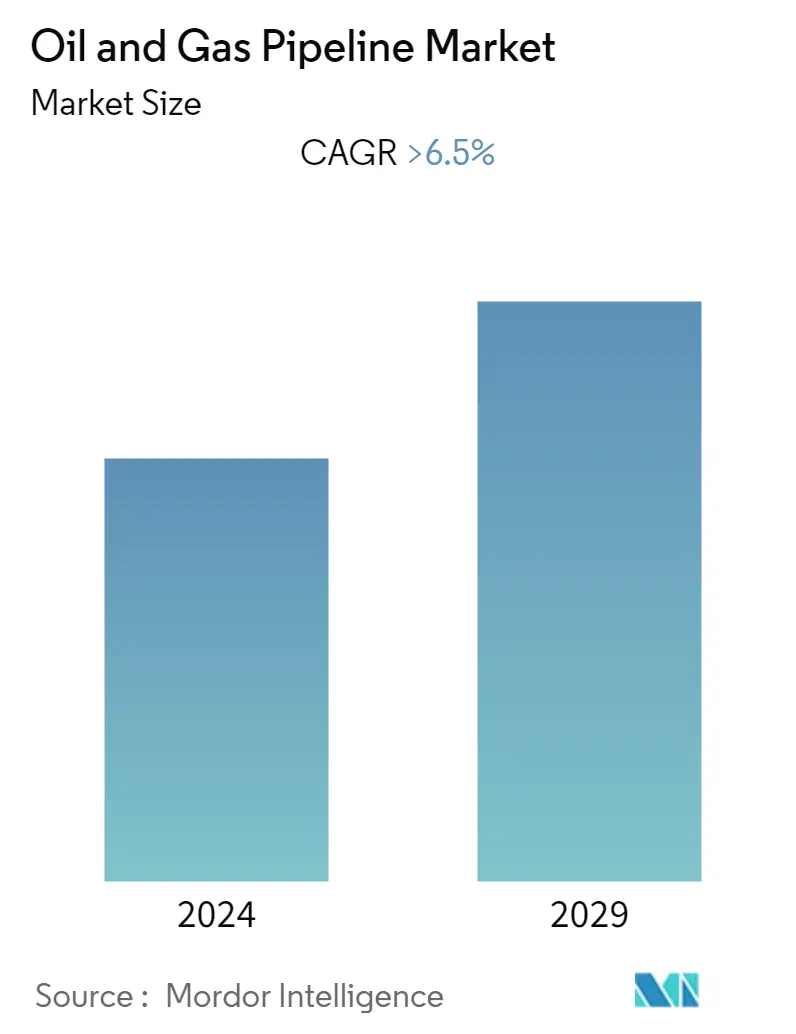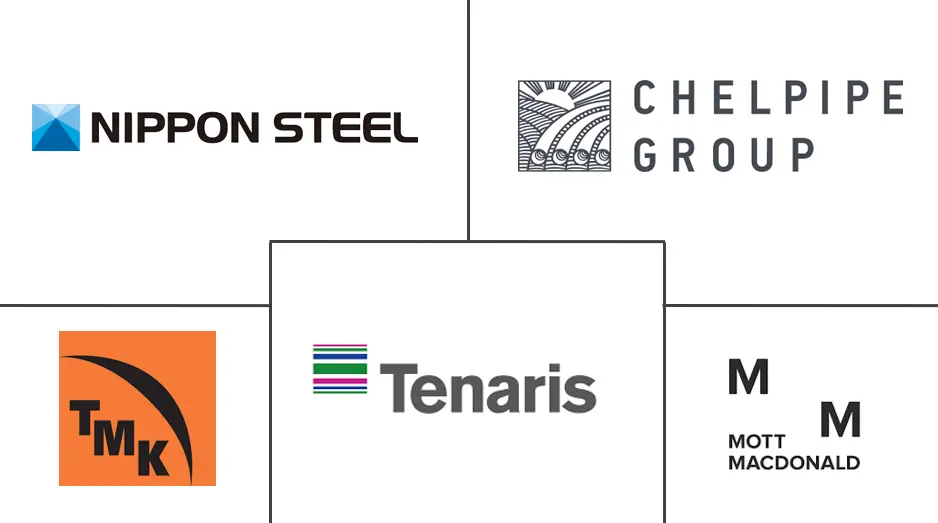Market Size of Oil and Gas Pipeline Industry

| Study Period | 2019 - 2029 |
| Base Year For Estimation | 2023 |
| CAGR | > 6.50 % |
| Fastest Growing Market | Asia Pacific |
| Largest Market | North America |
| Market Concentration | Low |
Major Players
*Disclaimer: Major Players sorted in no particular order |
Oil and Gas Pipeline Market Analysis
The oil and gas pipeline market is expected to register a CAGR of more than 6.5% during the forecast period.
The market was negatively impacted by the outbreak of COVID-19. Currently, the market has reached pre-pandemic levels.
- In a bid to meet the rising oil and gas consumption, the pipeline capacities are being expanded, and new pipeline projects are being commissioned. Moreover, an increase in offshore activities, such as deepwater and ultra-deepwater production and development, is driving the oil and gas pipeline market. Also, The availability of abundant natural gas reserves and the lower cost in comparison to other fossil fuel types, among others, are expected to supplement the demand for natural gas from multiple end-use sectors, including power generation. This, in turn, is expected to boost the gas pipeline market during the forecast period.
- However, the global shift toward renewable sources for electricity generation poses a massive threat to oil and gas demand, which is likely to be a significant challenge for oil and gas pipeline installation growth in the coming years.
- Russia and Pakistan have agreed to build a new gas-carrying pipeline worth USD 2 billion. India and Russia also signed a deal worth USD 40 billion on natural gas exports to India. Such large-scale projects are expected to drive the pipeline industry to grow more, and this is expected to present an opportunity for the market players in the near future.
- Asia-Pacific is expected to witness significant growth in the pipeline market due to the increasing demand for oil and gas from the major countries in the region. China and India have been the largest consumers of oil and gas in the Asia-Pacific region, and the pipeline network is growing at a significant pace in both countries.
Oil and Gas Pipeline Industry Segmentation
Pipeline transport is the long-distance transportation of a liquid or gas through a system of pipes, a pipeline, typically to a market area for consumption. The oil and pipeline business concentrates on the transportation, processing, and storage of crude oil and natural gas.
The oil and gas pipeline market is segmented by type, location of deployment, and geography. By type, the market is segmented into crude oil pipelines and gas pipelines. By location of deployment, the market is segmented into onshore and offshore. The report also covers the market size and forecasts for the oil and gas pipeline market across major regions. For each segment, the market sizing and forecasts have been done based on revenue (USD billion).
| Location of Deployment | |
| Onshore | |
| Offshore |
| Type | |
| Crude Oil Pipeline | |
| Gas Pipeline |
| Geography | |
| North America | |
| Europe | |
| Asia-Pacific | |
| South America | |
| Middle-East and Africa |
Oil and Gas Pipeline Market Size Summary
The oil and gas pipeline industry is poised for significant growth, driven by the expansion of pipeline capacities and the commissioning of new projects to meet the increasing demand for oil and gas. The market has rebounded to pre-pandemic levels after the initial setbacks caused by COVID-19. Key factors propelling the industry include the rise in offshore activities, such as deepwater and ultra-deepwater production, and the abundant availability of natural gas reserves, which is more cost-effective than other fossil fuels. This surge in natural gas demand, particularly from sectors like power generation, is expected to bolster the gas pipeline market. However, the global shift towards renewable energy sources presents a challenge to the growth of oil and gas pipeline installations.
Asia-Pacific is anticipated to experience substantial growth in the pipeline market, fueled by the increasing oil and gas consumption in major countries like China and India. The region's pipeline network is expanding rapidly to accommodate this demand. Significant projects, such as the agreements between Russia and Pakistan to build a new gas pipeline and the deal between India and Russia for natural gas exports, are expected to drive further industry growth. The development of new natural gas sources, including shale gas, and the resulting international trade dynamics are also contributing to the demand for pipeline infrastructure expansion. The market is moderately fragmented, with key players like Nippon Steel Corporation, Tenaris Inc., and TMK Group actively participating in various projects worldwide.
Oil and Gas Pipeline Market Size - Table of Contents
-
1. MARKET OVERVIEW
-
1.1 Introduction
-
1.2 Market Size and Demand Forecast in USD billion, till 2028
-
1.3 Recent Trends and Developments
-
1.4 Government Policies and Regulations
-
1.5 Market Dynamics
-
1.5.1 Drivers
-
1.5.2 Restraints
-
-
1.6 Supply Chain Analysis
-
1.7 Porter's Five Forces Analysis
-
1.7.1 Bargaining Power of Suppliers
-
1.7.2 Bargaining Power of Consumers
-
1.7.3 Threat of New Entrants
-
1.7.4 Threat of Substitutes Products and Services
-
1.7.5 Intensity of Competitive Rivalry
-
-
-
2. MARKET SEGMENTATION
-
2.1 Location of Deployment
-
2.1.1 Onshore
-
2.1.2 Offshore
-
-
2.2 Type
-
2.2.1 Crude Oil Pipeline
-
2.2.2 Gas Pipeline
-
-
2.3 Geography
-
2.3.1 North America
-
2.3.2 Europe
-
2.3.3 Asia-Pacific
-
2.3.4 South America
-
2.3.5 Middle-East and Africa
-
-
Oil and Gas Pipeline Market Size FAQs
What is the current Oil and Gas Pipeline Market size?
The Oil and Gas Pipeline Market is projected to register a CAGR of greater than 6.5% during the forecast period (2024-2029)
Who are the key players in Oil and Gas Pipeline Market?
Tenaris Inc., TMK Group , Mott Macdonald Group Ltd. , Nippon Steel Corporation and ChelPipe Group are the major companies operating in the Oil and Gas Pipeline Market.

